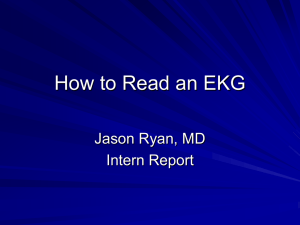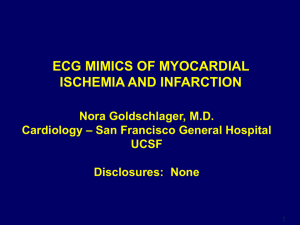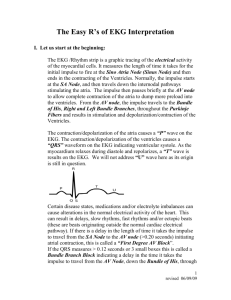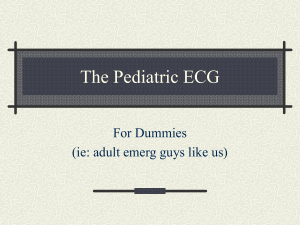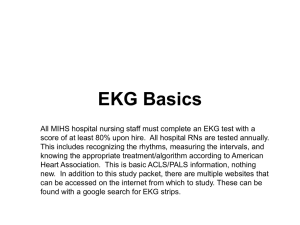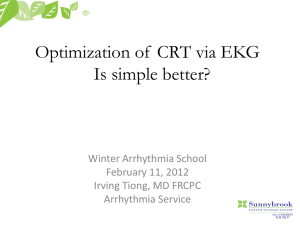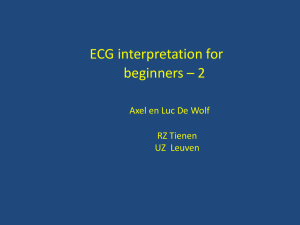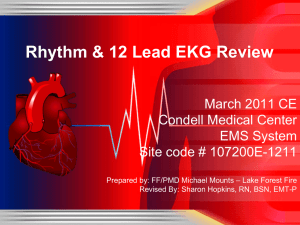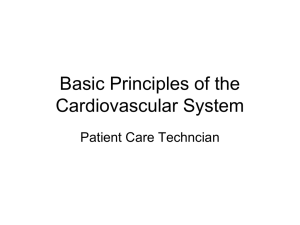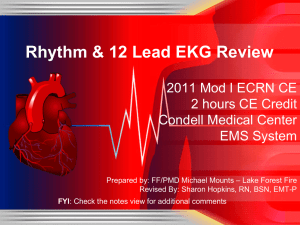EKG TUTORIAL - South Jersey Heart Group
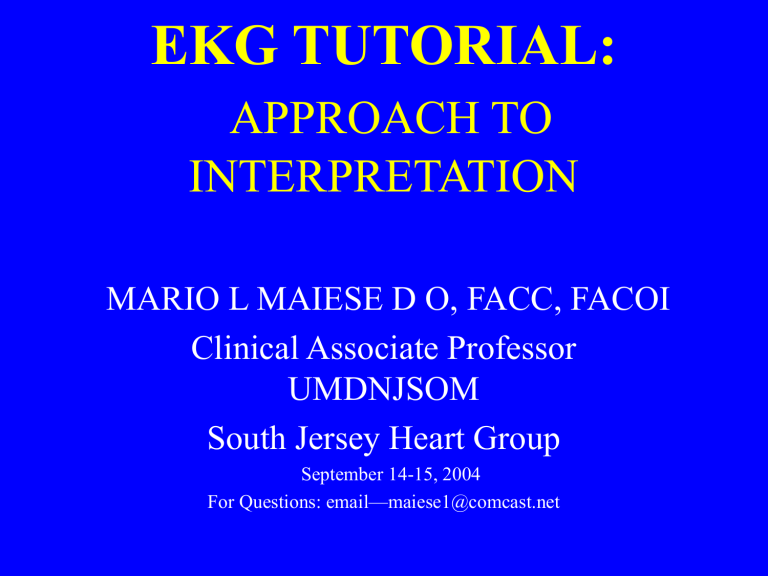
EKG TUTORIAL:
APPROACH TO
INTERPRETATION
MARIO L MAIESE D O, FACC, FACOI
Clinical Associate Professor
UMDNJSOM
South Jersey Heart Group
September 14-15, 2004
For Questions: email—maiese1@comcast.net
Rapid Interpretation of EKG’S
Dale Dubin, MD
(required reading before the lecture)
PRIORITIES?
6 Step Approach
1 Rate and Rhythm
2 PR interval
3 QRS interval
4 Signs of MI
5 Signs of Hypertrophy
6 ST/QT/ T wave abnormalities
12-lead EKG Interpretation
Six Step Approach
1) rate and rhythm
• big box (0.20 sec) rule (for 1,2,3,4,5,& 6 boxes)
300,150,100,75,60,50
--- 60-100 inclusive? YES
--- < 60 => bradycardia
--- > 100 => tachycardia
•
unsure of rhythm? YES Arrhythmia ID
6 Step Approach
1 Rate and Rhythm
2 PR interval
3 QRS interval
4 Signs of MI
5 Signs of Hypertrophy
6 ST/QT/ T wave abnormalities
12-lead EKG Interpretation
Six Step Approach
2) PR interval [nl 0.12-0.20 inclusive] nl
•
PR< 0.12 sec? YES Pre-Excitation Syndrome
[PES]; 11 poss Variants; delta wave with prolonged QRS Wolff-
Parkinson- White
] Syndrome
•
PR> 0.20 sec [including dropped beats] ? YES
6 Step Approach
1 Rate and Rhythm
2 PR interval
3 QRS interval/ Axis
4 Signs of MI
5 Signs of Hypertrophy
6 ST/QT/ T wave abnormalities
12-lead EKG Interpretation
Six Step Approach
3) QRS interval [nl < 0.10 sec]
QRS> 0.10 sec YES differential for wide
QRS [bundle branch block{BBB}pattern]
6 Step Approach
1 Rate and Rhythm
2 PR interval
3 QRS interval
4 Signs of MI
5 Signs of Hypertrophy
6 ST/QT/ T wave abnormalities
12-lead EKG Interpretation
Six Step Approach
4) signs of transmural [Q wave infarction]?
• Q waves > 0.04 sec in limb leads YES + criteria for MI
• Q waves > 1/4 height of the R wave in the same lead YES + criteria for MI
• Q waves in more than one limb lead YES + criteria for MI
• abnormal R wave progression in precordial [chest] leads YES
6 Step Approach
1 Rate and Rhythm
2 PR interval
3 QRS interval
4 Signs of MI
5 Signs of Hypertrophy
6 ST/QT/ T wave abnormalities
12-lead EKG Interpretation
Six Step Approach
5) signs of hypertrophy[increased voltage of
QRS complexes]
• Right Ventricular Hypertrophy [
• Left Ventricular Hypertrophy [
]
6 Step Approach
1 Rate and Rhythm
2 PR interval
3 QRS interval
4 Signs of MI
5 Signs of Hypertrophy
6 ST/QT/ T wave abnormalities
12-lead EKG Interpretation
Six Step Approach
ST seg depression [>1mm]? YES ischemia
ST scooping? YES digitalis effect
• prolonged QT with flat T wave? YES hypo K+
• early peaked T waves? YES hyper K+
ARRHYTHMIA
IDENTIFICATION
• Rhythm: regular regular
regular irregular
irregular irregular
• P wave not present absent P waves [escape
(late) rhythms] more P waves than QRSs AV block
ARRHYTHMIA
IDENTIFICATION
• QRS Complex
-all narrow nl QRS complexes
-mixed narrow and wide homogeneous unifocal ventricular ectopy heterogeneous multifocal ventricular ectopy
-all wide wide QRS complexes
Differential for Prolonged PR Interval
• P with every QRS 1st degree heart block
• progressive PR prolongation with dropped beats
2nd degree heart block [Mobitz type
1(Wenckebach)]
• constant PR with dropped beats 2nd degree heart block [Mobitz type 11 ]
• no relationship between p waves and QRS 3rd degree heart block
Differential for Wide QRS
• No P waves
-all negative in V6 => V tach
-bizzare axis => V tach
• PR < 0.12 sec => WPW [QRS> 0.10 & < 0.12]
• initial QRS peaked [upright] in V1? YES right bundle branch block (
• QRS wide [downward deflection] overall inV1-V6
[QRS> 0.12]? YES left bundle branch block
Differential for Wide QRS
• LBBB pattern [QRS < 0.12] with axis < 45 degrees? YES left anterior hemiblock
]
• LBBB pattern [QRS < 0.12 with axis > 120 degrees? YES left posterior hemiblock
]
Criteria for Infarct Age
• Significant ST segment elevation? YES acute infarct [days]
• Q waves with inverted T waves ? YES recent (“subacute”)
[days/weeks/months]
• significant Q waves only? YES old
[months/years]
Regular Rhythms
• P wave with every normal QRS => normal sinus rhythm [NSR]--rate 60-100 inclusive
• P wave with every normal QRS/slow [<60] => supraventricular bradycardia
• P wave with every normal QRS/fast [>100] => supraventricular tachycardia
Premature/Missed Beats
• premature beats [early]
wide/same=> unifocal ventricular ectopy
wide/different => multifocal ventricular ectopy
• dropped beats without PR =>
• no relationship between P and QRS =>
Chaotic Rhythms
• No P waves [undulating baseline]/irregular ventricular response => atrial fibrillation
• heterogenious P waves [at least 3 different P wave configurations usually with varying
PR intervals => multifocal atrial rhythm
[if
HR > 100 => multifocal atrial tach
Rhythms
• Normal
• Abnormal: Arrhythmia
Dysrhythmia
Supraventricular Dysrhythmias
Atrioventricular (AV) Block
Myocardial Infarction
Ventricular conduction abnormalities
Ventricular Dysrhythmias
Pre-Excitation Syndrome (PES)
Experience is a wonderful thing .
It enables you to recognize a mistake when you make it again.
Average but works hard,
Beats
Brilliant but lazy.
1) A 45 yr old black man is noted to have a BP of 150/100. He has been hypertensive the last
10 years. What is the abnormality on the
EKG?
2) What is the cause of the patients’s rapid irregular pulse?
3) What is the cause of the wide
QRS complex?
4) The patient complains of
“extra” beats. What is the arrhythmia? Tx?
5) What is the arrhythmia?
6) A patient complains of palpatations. What is the arrhythmia?
7) The following EKG is obtained during a cardiac arrest.
What is the arrhythmia?
8) What is the cause of the patient’s rapid irregular pulse?
9) How does the rhythm change abruptly in this patient?
10) What arrhythmia and conduction disturbance are present on this V1 rhythm strip?
11) What arrhythmia is present in this patient?
12) A 50 yr.-old man presents with chest discomfort. The EKG is most consistent with which diagnosis?
Acute inferior wall MI
Acute pericarditis
Normal variant “early repolarization”
Ventricular aneurysm
13) A 63 yr.-old woman had severe chest pain 6 hours ago.
What does the EKG show?
14) What conduction disturbance is present?
Atherothrombotic
Lesion development
Mechanism of Plaque Disruption in
Atherothrombosis ( Acute thrombus )
15) A 53 yr old man presents with crushing chest pain. He is hypotensive with jugular venous distention. What is the EKG diagnosis?
16) A patient has recurrent syncope. What is the diagnosis?
17) The following rhythm strip is obtained post exercise. What is the diagnosis?
18) What arrhythmia and conduction disturbance are present?
19) What conduction abnormality is present?
20) What arrhythmia is responsible for the tachycardia in this patient with underlying chronic lung disease?
21) What dysrhythmia is causing the tachycardia? What other abnormal finding is present?
22) A 62 year old women presents with the sudden onset of acute crushing chest pain.
What is the diagnosis?
“To look is one thing;
To see what you look at is another,
To understand what you see is a third;
To learn from what you understand is still something else,
But to act on what you learn is all that really matters!”
Be Sincere
Be simple in words, manners and gestures.
Amuse as well as instruct.
If you can make a man laugh you can make him think and believe you.
•
D:\Clock.htm
Time is Up
Experience is a wonderful thing .
It enables you to recognize a mistake when you make it again.
